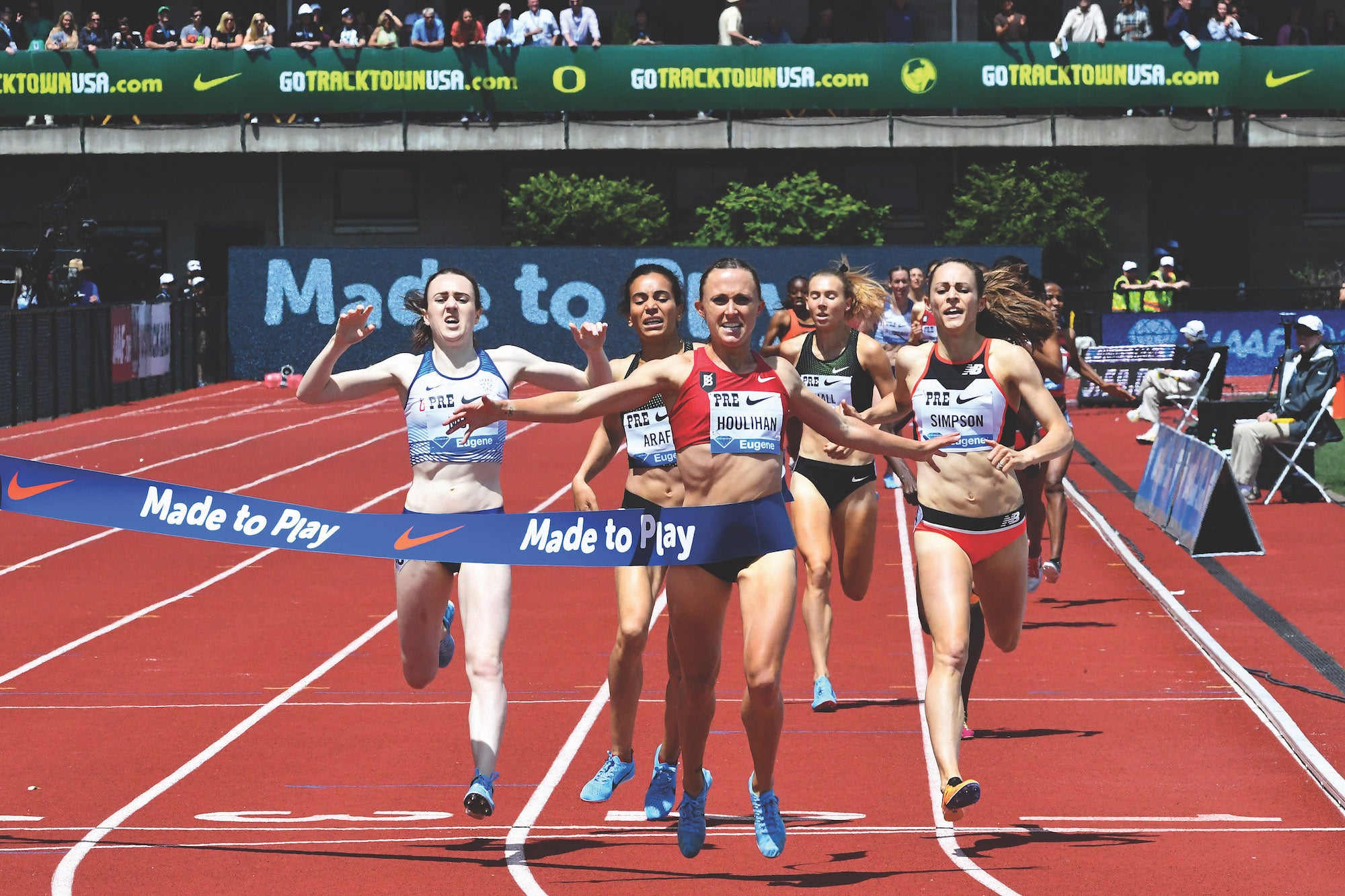They’re Flying! Faster Runners Catch More Air—And You Can, Too

PHOTO: PhotoRun At the 2018 Prefontaine Classic, the professional field of women fly to the finish line of the 1500 meters.
Sure, they’re fitter and genetically gifted humans, but did you ever wonder what else contributes to the speed of the fastest runners?
A study published in December in the European Journal of Sport Science suggests that fast runners also move differently, spending less time on the ground. Many previous studies examined biomechanical differences between faster and slower runners, but the observations were generally made in race conditions or on treadmills. This study recruited 14 high-performance and 14 recreational runners (eight of each group were male runners) to run identical paces on a track.
The participants in the study, conducted by Stephen Preece and his University of Salford colleagues, analyzed the runners’ biomechanics at five, six, seven, and eight minutes per mile. Results showed that the elites didn’t have a longer stride or faster cadence—instead, they spent 11 percent more time in the air than the recreational group. In effect, the familiar phrase is accurate: faster runners really are “flying.”
So, short of sprouting wings, how can you start flying? This research says that common advice like increasing cadence probably won’t help. Although you’re covering more steps at a faster rate, you’re covering less ground with each step.
“People think [more steps] means they will run faster, but it often actually leads to runners shortening their stride,” Preece said.
Lengthening your stride is also an unhelpful cue. This study shows that faster runners have equivalent stride length to slower runners. Also, trying to take bigger strides can lead to over-striding, where your foot is landing in front of your knee. At best, this hinders your running efficiency by causing you to hit the ground heel-first, which creates a braking effect. At worst, over-striding can overwork your hip muscles and cause injury.
Instead, Preece and his coauthor Chris Bramah, a fellow University of Salford researcher and physiotherapist who regularly performs gait analyses at the Manchester Institute of Health and Performance, suggest focusing on the following cues to improve your running form and increase your hang time:
Landing with your foot under your body. Preece recommends taking a video of yourself running on a treadmill. Set up the phone to film from the side, and when you watch the video afterward, draw a line from your knee to your ankle bone. The closer your foot is to landing under your body (rather than in front of it), the more vertical that line, representing your shin angle, will be.
If you find that your shin angle is tilted forward, work with a running coach or physical therapist to correct it—but make changes gradually. Trying to alter your mechanics too quickly, Preece said, “will put more of a load on your calf muscle. So don’t do it overnight.”
Landing with a slightly bent knee. This is advantageous in two ways. First, like the previous cue, this helps prevent over-striding. (It’s hard to land with a bent knee while your foot is extended out in front of you.) Second, landing with your knee slightly bent engages the muscles around the knee and ankle the moment you hit the ground, which should result in a stronger push-off later in the running cycle.
One drill you can do to work on this is called “ankle dribbles.” In this drill, focus on stepping directly over the height of your ankle, quickly landing on your heel and transitioning through the full length of the foot as you take the next step. Stay tall, and don’t forget to swing your arms naturally, as you do when you run.
“Catching the ground.” You want your knee to bend just before your foot hits the ground. This is challenging to feel, but visualization cues can help. Imagine a horse pawing the ground, or pretend you are scraping gum off the bottom of your shoe. Essentially you are trying to pull your foot underneath your body as you run in order to catch the ground and keep moving forward.
Of all three movements, this is the one to master: if you get it right, your knee will be slightly bent as you touch down, and your foot will be closer to your center of mass. “B skips” can help get you there.
Start with a small skip forward on your left foot, keeping that left leg straight, as you raise your right knee to waist height. (This first part of the movement is called an “A skip” and is a drill in its own right. Practice until this feels comfortable.) Then complete the “B skip” by skipping again on that left foot as you extend your right leg out in front of you and power your foot down and backward to claw the ground with your right forefoot. The focus here is not on the extension of your knee, but on the backward “scraping” contact of your foot with the ground.
You’ll be flying in no time.